 | | | Switch to: Europe, USA, New Zealand, Antarctica Credit: NOAA/Ovation  Planetary K-index Planetary K-index
Now: Kp= 1 quiet
24-hr max: Kp= 2 quiet
explanation | more data
Interplanetary Mag. Field
Btotal: 4.5 nT
Bz: 4.2 nT north
more data: ACE, DSCOVR
Updated: Today at 2345 UT  Coronal Holes: 03 Sep 18 Coronal Holes: 03 Sep 18 
Solar wind flowing from this coronal hole should reach Earth on Sept. 7th. Credit: SDO/AIA  Noctilucent Clouds The season for noctilucent clouds in he northern hemisphere is underway. Check here daily for the latest images from NASA's AIM spacecraft. Switch view: Europe, USA, Asia, Polar Updated at: 09-03-2018 14:55:02 Noctilucent Clouds The season for noctilucent clouds in he northern hemisphere is underway. Check here daily for the latest images from NASA's AIM spacecraft. Switch view: Europe, USA, Asia, Polar Updated at: 09-03-2018 14:55:02  SPACE WEATHER
NOAA Forecasts | | Updated at: 2018 Sep 03 2200 UTC FLARE | 0-24 hr | 24-48 hr | CLASS M | 01 % | 01 % | CLASS X | 01 % | 01 % |  Geomagnetic Storms: Geomagnetic Storms:
Probabilities for significant disturbances in Earth's magnetic field are given for three activity levels: active, minor storm, severe storm Updated at: 2018 Sep 03 2200 UTC Mid-latitudes | 0-24 hr | 24-48 hr | ACTIVE | 15 % | 10 % | MINOR | 01 % | 01 % | SEVERE | 01 % | 01 % | High latitudes | 0-24 hr | 24-48 hr | ACTIVE | 15 % | 15 % | MINOR | 25 % | 20 % | SEVERE | 20 % | 15 % | | | |  | | | | | | | | | | | Lights Over Lapland has a brand-new website full of exciting adventures in Abisko National Park, Sweden! Take a look at our aurora activities and book your once-in-a-lifetime trip with us today! | | | 159 YEARS AGO, A GEOMAGNETIC MEGA-STORM: On Sept. 2, 1859, a powerful CME rocked Earth's magnetic field, causing a geomagnetic storm that set fire to Victorian telegraph offices and sparked auroras as far south as Mexico and Cuba. Now known as the "Carrington Event," that megastorm 159 years ago is a touchstone of modern extreme space weather research. What are the odds it could happen again? Find out here. CORONAL HOLE FACES EARTH: A hole in the sun's atmosphere is directly facing Earth and spewing a stream of solar wind toward our planet. NASA's Solar Dynamics Observatory photographed the structure using an extreme UV camera on Sept. 3rd: 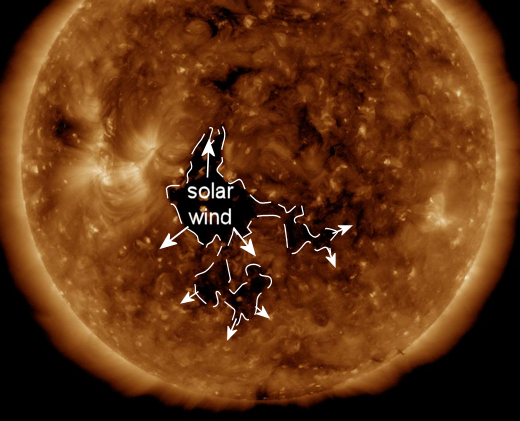
This is a "coronal hole"--a region where the sun's magnetic field opens up and allows solar wind to escape. It looks dark in extreme UV images of the sun because the hot glowing plasma normally contained there is missing. In this case, the gaseous material is en route to Earth.
Minor geomagnetic storms are possible on Sept. 7th when the solar wind arrives. Arctic sky watchers have started seeing auroras with regularity in recent weeks as summer sunlight fades and autumn approaches. Adding a stream of solar wind to the mix will improve the light show even more. Free: Aurora Alerts.
Realtime Space Weather Photo Gallery FLY ME TO THE MOONSTONE: Are you looking for a far-out gift? Nothing says "I love you" like a moonstone from the edge of space. On June 12th, the students of Earth to Sky Calculus flew this moonstone wrapped in a sterling silver Celtic love knot 34.1 km (111,877 feet) above Earth's surface: 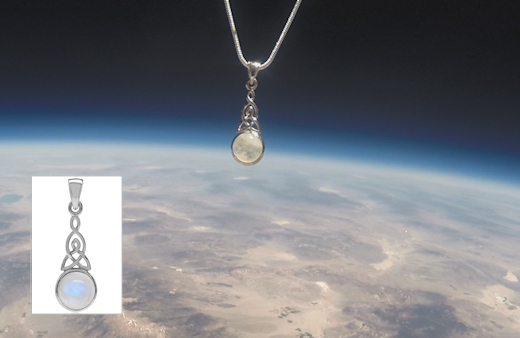
You can have it for $139.95. The students are selling these pendants to support their cosmic ray ballooning program. Each one comes with a greeting card showing the item in flight and telling the story of its journey to the edge of space. Sales support the Earth to Sky Calculus cosmic ray ballooning program and hands-on STEM research. Far Out Gifts: Earth to Sky Store
All sales support hands-on STEM education AUTUMN IS COMING: The northern autumnal equinox is now only 3 weeks away. Residents of Arctic Canada don't need a calendar to tell them that, however. The signs are in the sky. "Last night (Sept. 1st), auroras came out at dusk and kept dancing all night long," reports Yuichi Takasaka, who sends this picture from Yellowknife in the Northwest Territories: 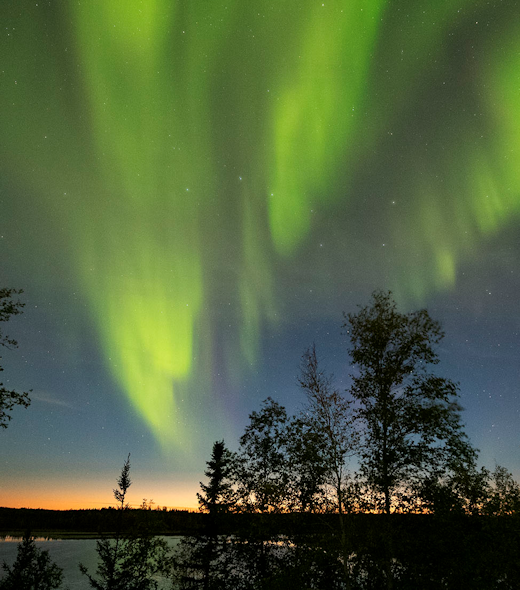
Displays like these are a sign that autumn is coming. Researchers have long known that, during weeks around equinoxes, cracks form in Earth's magnetosphere. Solar wind can pour through the gaps to fuel bright displays of Arctic lights. This is called the the "Russell-McPherron effect," named after the researchers who first explained it. A recent study covering 75 years of historical geomagnetic records shows that September-October are among the most geomagnetically active months of the year–a direct result of "equinox cracks." Free: Aurora Alerts. Realtime Aurora Photo Gallery Every night, a network of NASA all-sky cameras scans the skies above the United States for meteoritic fireballs. Automated software maintained by NASA's Meteoroid Environment Office calculates their orbits, velocity, penetration depth in Earth's atmosphere and many other characteristics. Daily results are presented here on Spaceweather.com. On Sep. 3, 2018, the network reported 85 fireballs.
(84 sporadics, 1) 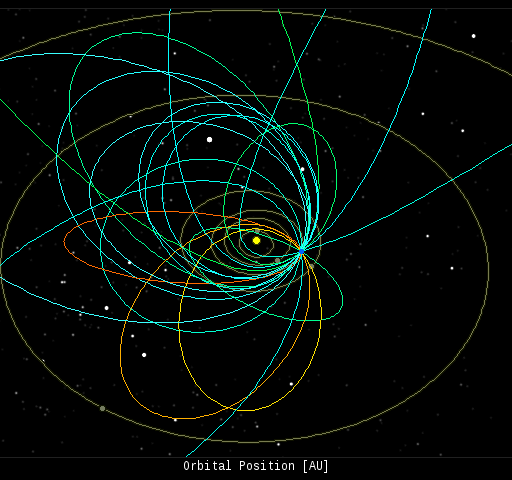 In this diagram of the inner solar system, all of the fireball orbits intersect at a single point--Earth. The orbits are color-coded by velocity, from slow (red) to fast (blue). [Larger image] [movies] Potentially Hazardous Asteroids ( PHAs) are space rocks larger than approximately 100m that can come closer to Earth than 0.05 AU. None of the known PHAs is on a collision course with our planet, although astronomers are finding new ones all the time. On September 3, 2018 there were 1923 potentially hazardous asteroids.
 | Recent & Upcoming Earth-asteroid encounters: | Asteroid | Date(UT) | Miss Distance | Velocity (km/s) | Diameter (m) | | 2016 NF23 | 2018-Aug-29 | 13.2 LD | 9 | 93 | | 1998 SD9 | 2018-Aug-29 | 4.2 LD | 10.7 | 51 | | 2018 DE1 | 2018-Aug-30 | 15.2 LD | 6.5 | 28 | | 2018 RA | 2018-Sep-01 | 3 LD | 6.9 | 16 | | 2001 RQ17 | 2018-Sep-02 | 19.3 LD | 8.3 | 107 | | 2015 FP118 | 2018-Sep-03 | 12.3 LD | 9.8 | 490 | | 2018 QA | 2018-Sep-03 | 17.5 LD | 20.4 | 73 | | 2018 QU1 | 2018-Sep-11 | 10.9 LD | 12.5 | 101 | | 2017 SL16 | 2018-Sep-20 | 8.5 LD | 6.4 | 25 | | 2018 EB | 2018-Oct-07 | 15.5 LD | 15.1 | 155 | | 2014 US7 | 2018-Oct-17 | 3.2 LD | 8.7 | 19 | | 2013 UG1 | 2018-Oct-18 | 10.4 LD | 13.4 | 123 | | 2016 GC221 | 2018-Oct-18 | 8.7 LD | 14.4 | 39 | | 475534 | 2018-Oct-29 | 7.5 LD | 18.1 | 204 | Notes: LD means "Lunar Distance." 1 LD = 384,401 km, the distance between Earth and the Moon. 1 LD also equals 0.00256 AU. MAG is the visual magnitude of the asteroid on the date of closest approach. | | Cosmic Rays in the Atmosphere | SPACE WEATHER BALLOON DATA: Approximately once a week, Spaceweather.com and the students of Earth to Sky Calculus fly space weather balloons to the stratosphere over California. These balloons are equipped with radiation sensors that detect cosmic rays, a surprisingly "down to Earth" form of space weather. Cosmic rays can seed clouds, trigger lightning, and penetrate commercial airplanes. Furthermore, there are studies ( #1, #2, #3, #4) linking cosmic rays with cardiac arrhythmias and sudden cardiac death in the general population. Our latest measurements show that cosmic rays are intensifying, with an increase of more than 18% since 2015: 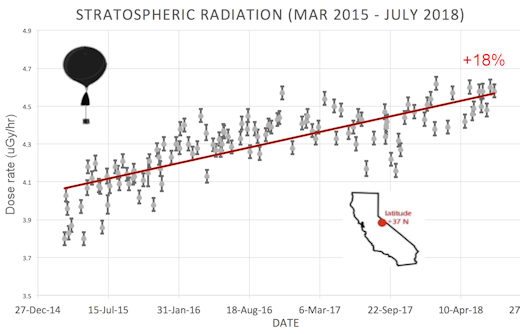
The data points in the graph above correspond to the peak of the Reneger-Pfotzer maximum, which lies about 67,000 feet above central California. When cosmic rays crash into Earth's atmosphere, they produce a spray of secondary particles that is most intense at the entrance to the stratosphere. Physicists Eric Reneger and Georg Pfotzer discovered the maximum using balloons in the 1930s and it is what we are measuring today. En route to the stratosphere, our sensors also pass through aviation altitudes: 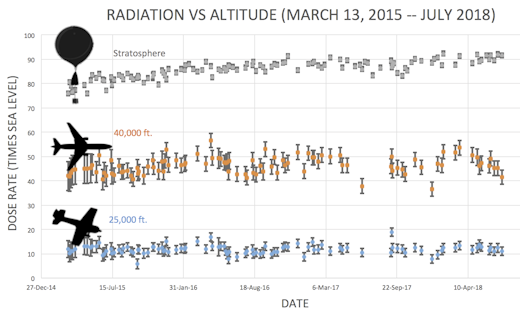
In this plot, dose rates are expessed as multiples of sea level. For instance, we see that boarding a plane that flies at 25,000 feet exposes passengers to dose rates ~10x higher than sea level. At 40,000 feet, the multiplier is closer to 50x. The radiation sensors onboard our helium balloons detect X-rays and gamma-rays in the energy range 10 keV to 20 MeV. These energies span the range of medical X-ray machines and airport security scanners. Why are cosmic rays intensifying? The main reason is the sun. Solar storm clouds such as coronal mass ejections (CMEs) sweep aside cosmic rays when they pass by Earth. During Solar Maximum, CMEs are abundant and cosmic rays are held at bay. Now, however, the solar cycle is swinging toward Solar Minimum, allowing cosmic rays to return. Another reason could be the weakening of Earth's magnetic field, which helps protect us from deep-space radiation. | | The official U.S. government space weather bureau | | | The first place to look for information about sundogs, pillars, rainbows and related phenomena. | | | Researchers call it a "Hubble for the sun." SDO is the most advanced solar observatory ever. | | | 3D views of the sun from NASA's Solar and Terrestrial Relations Observatory | | | Realtime and archival images of the Sun from SOHO. | | | from the NOAA Space Environment Center | | | fun to read, but should be taken with a grain of salt! Forecasts looking ahead more than a few days are often wrong. | | | from the NOAA Space Environment Center | | | the underlying science of space weather |  | If you are a Youtuber and want to buy real Youtube views than try out Buyrealsocial.com for the best results possible! |  | To find reviews of new online casino sites in the UK try The Casino DB where there are hundreds of online casino reviews complete with bonuses and ratings. | | | These links help Spaceweather.com stay online. Thank you to our supporters! | | | | | | | | |  | |  |   | ©2017 Spaceweather.com. All rights reserved. This site is penned daily by Dr. Tony Phillips. | |

